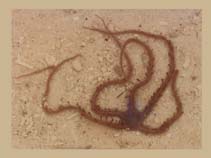Ophiomastix annulosa (Lamarck, 1816)
Chain-link brittle starWarning: DOMDocument::load(): SSL operation failed with code 1. OpenSSL Error messages: error:140770FC:SSL routines:SSL23_GET_SERVER_HELLO:unknown protocol in C:\Apache24\htdocs\includes\SpeciesSummary.lib.php on line 1236
Warning: DOMDocument::load(): Failed to enable crypto in C:\Apache24\htdocs\includes\SpeciesSummary.lib.php on line 1236
Warning: DOMDocument::load(https://sealifebase.nrm.se/webservice/AquaMaps/getAMap.php?genus=Ophiomastix&species=annulosa): failed to open stream: operation failed in C:\Apache24\htdocs\includes\SpeciesSummary.lib.php on line 1236
Warning: DOMDocument::load(): I/O warning : failed to load external entity "https://sealifebase.nrm.se/webservice/AquaMaps/getAMap.php?genus=Ophiomastix&species=annulosa" in C:\Apache24\htdocs\includes\SpeciesSummary.lib.php on line 1236
Classification / Names Common names | Synonyms | CoL | ITIS | WoRMS
| Ophiacanthida | Ophiocomidae
Environment: milieu / climate zone / depth range / distribution range Ekologi
Revassocierade; djupintervall 4 - 11 m (Ref. 81187). Tropical
Utbredning Länder | FAO områden | Ekosystem | Förekomster | Utplanteringar
Indo-West Pacific: from Maldives to China.
Length at first maturity / Size / Vikt / Age
Maturity: Lm ? range ? - ? cm Max length : 2.4 cm WD hane/ej könsbestämd; (Ref. 87041)
Depth information reported for China (Ref. 81187). Size refers to disk diameter (Ref. 87041). Found beneath coral slabs and in holes and crevices. Possesses enlarged, modified, venomous spines (Ref. 800). Subtidal. Association with Ophiomastix scolopendrina may serve as its strategy in obtaining food from the host's arms (Ref. 102356).
Life cycle and mating behavior Könsmognad | Reproduktion | Lek | Ägg | Fecundity | Larver
Members of the class Ophiuroidea are mostly gonochoric, others are protandric. Fertilization is external. Brooding is common, bursae is used as brood chambers where the embryos develop into juveniles and later crawl out from the bursal slits. Life cycle: Embryos hatch into free-swimming planktotrophic larvae and later metamorphose into tiny brittle stars which sink down the bottom where they grow into adult form.
Main reference
referenser | Koordinator | Medarbetare
Schoppe, S. 2000. (Ref. 800)
IUCN Red List Status (Ref. 130435)
CITES status (Ref. 108899)
Not Evaluated
CMS (Ref. 116361)
Not Evaluated
Threat to humans
Harmless
Human uses
| FishSource |
Verktyg
Ytterligare information
Age/Size
Tillväxt
Length-weight
Length-length
Morfologi
Larver
Abundans
Tillväxt
Length-weight
Length-length
Morfologi
Larver
Abundans
Internet-källor
BHL | BOLD Systems | CISTI | DiscoverLife | FAO(Publication : search) | Fishipedia | GenBank (genome, nucleotide) | GloBI | Gomexsi | Google Books | Google Scholar | Google | PubMed | Tree of Life | Wikipedia (Go, sök) | Zoological Record
Estimates based on models
Preferred temperature
(Ref. 115969): 24.9 - 29.3, mean 28.4 (based on 2609 cells).
Price category
(Ref. 80766):
Unknown.



